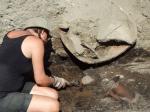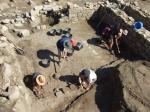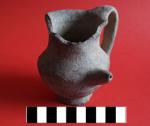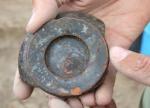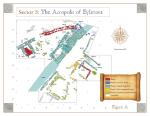Summary (English)
The paved ramp discovered in 2008 was followed to the south and uphill on the acropolis. The ramp appears to be part of a propylon, leading to a pebbled roadway which continues further up the acropolis hill. A number of well-preserved buildings with unknown function flank this road. The discovery of certain re-used architectural fragments (a triglyph and metope) indicates that a Greek style temple may be located somewhere nearby on the acropolis. It seems that the acropolis of Bylazora was terraced, since the contemporary buildings of the acropolis were constructed on different levels following the ancient topography of the hill.
A great deal of ancient pottery was discovered in both seasons. Most of the finds are of local Paionian production, but there also is a large quantity of imported pottery from the ancient Macedonian centres and Athens.The investigations of 2008 and 2009 seasons allows the establishment of a relative chronology for this section of the acropolis of Bylazora:
1st Period. Pre-Propylon: The ramp-propylon has within it stones that appear to have been taken from earlier buildings. The trenches have revealed a massive destruction layer beneath the propylon. The remnants of a large First Tower in the acropolis defensive wall may belong to this period. Other scattered structural remains on the acropolis are from a similar early period that dates around 400 BC.
2nd Period. Propylon: The ramp-propylon was built cutting through the defensive wall of the acropolis and a smaller Second Tower was built flanking the entrance to the ramp. There may have been a rebuilding of a section of the acropolis wall at this time. This phase dates from the early 4th century BC.
3rd Period. Destruction: Bylazora was attacked and this section of the city badly destroyed around 350 BC.4th Period. First Squatter Period: People moved into the ruins of the acropolis, using some of the better surviving walls of the older buildings, including the still-standing remnants of the ramp-propylon. It seems that this period ended around 280 BC and that the invasion of the Danubian Celts in 279 BC might be the reason for the destruction.
Director
- William Neidinger - Texas Foundation for Archaeological and Historical Research
Team
- Stefan Danev - Museum of Sveti Nikole
- Eulah Matthews - Texas Foundation for Archaeological and Historical Research
Research Body
- Museum of Sveti Nikole
Funding Body
- Texas Foundation of Archaeological and Historical Research





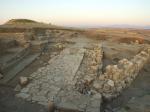
![Download [PDF]](/excavation/skins/fasti/images/results/download_sml.png)
